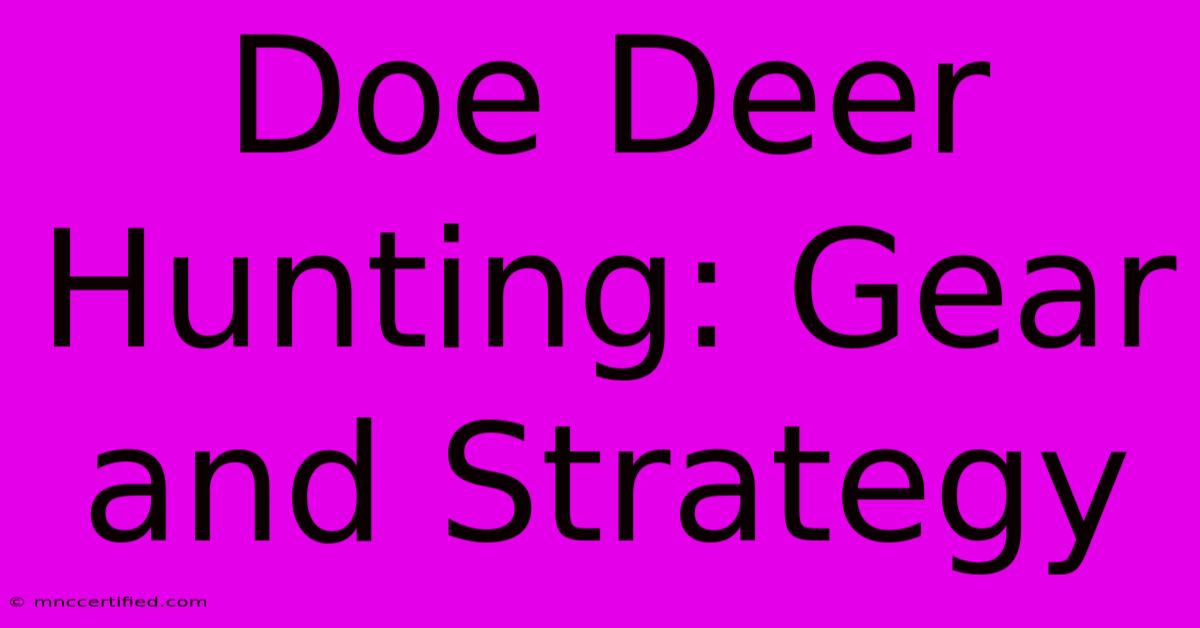Doe Deer Hunting: Gear And Strategy

Table of Contents
Doe Deer Hunting: Gear and Strategy for a Successful Hunt
Doe deer hunting presents unique challenges and rewards compared to buck hunting. Understanding doe behavior and employing the right gear and strategy significantly increases your chances of success. This comprehensive guide covers essential equipment and effective hunting tactics to help you bag your next doe.
Essential Gear for a Successful Doe Hunt
The right gear can mean the difference between a successful hunt and a fruitless day in the woods. Here's a breakdown of the essentials:
Firearm and Ammunition:
- Caliber Choice: A caliber suitable for deer hunting is crucial. Popular choices include .243 Winchester, .30-06 Springfield, .270 Winchester, and 7mm-08 Remington. Choose a round appropriate for your range and ethical harvest considerations. Remember to always practice safe firearm handling.
- Ammunition Selection: Select ammunition designed for deer hunting. Expanding bullets are essential for clean kills and ethical harvesting. Consider bullet weight and energy at your anticipated shooting distance.
Optics:
- Binoculars: Essential for spotting deer at a distance, especially in thick cover. Choose binoculars with a good magnification and field of view.
- Riflescope: A quality riflescope with appropriate magnification is vital for accurate shots. Consider features like a rangefinder or illuminated reticle for low-light hunting.
Clothing and Scent Control:
- Scent-Eliminating Clothing: Doe deer have a keen sense of smell. Invest in scent-eliminating clothing, including base layers, outerwear, and even gloves and boots. Properly washing and storing your hunting gear is also critical.
- Camouflage: Blending in with your surroundings is vital. Choose camouflage patterns appropriate for your hunting environment.
- Weather-Appropriate Clothing: Dress in layers to adapt to changing weather conditions. Stay warm and dry for maximum comfort and effectiveness.
Other Essential Gear:
- Backpack: Carry essential items like water, snacks, first-aid kit, knife, and extra ammunition.
- Hunting Knife: Essential for field dressing your harvest.
- Game Bags: Transport your harvested deer ethically and efficiently.
- Rangefinder: Accurately determine distances to your target for precise shot placement.
- Calls: While not always necessary, doe bleats and fawn distress calls can sometimes draw in deer. Practice using them beforehand.
- Headlamp or Flashlight: For safe navigation in low-light conditions.
Effective Strategies for Doe Deer Hunting
Understanding doe behavior is paramount to a successful hunt. Here are some key strategies:
Hunting Locations:
- Food Sources: Focus your efforts near food sources like agricultural fields, orchards, or areas with abundant natural browse.
- Water Sources: Deer need water, especially during dry periods. Locate water sources and hunt nearby.
- Travel Routes: Identify deer trails and travel routes. Set up your stand or blind along these pathways.
- Cover: Choose a hunting location that provides good cover and concealment. This allows you to remain unseen and undetected.
Hunting Techniques:
- Still Hunting: Slowly and quietly moving through the woods, looking for deer. This requires patience and keen observation skills.
- Stand Hunting: Setting up a tree stand or ground blind in a strategic location to wait for deer to come to you. This allows for longer periods of observation.
- Driving: This method involves pushing deer out of an area towards waiting hunters. Requires coordination and careful planning.
Understanding Doe Behavior:
- Breeding Season: During the rut (breeding season), does may be less predictable in their movements.
- Motherly Instincts: Does with fawns will be protective and may be more cautious.
- Feeding Patterns: Observe feeding patterns to determine the best time to hunt. Early mornings and evenings are often prime times.
Ethical Harvesting:
- Shot Placement: A precise shot placement is essential for a quick and humane kill. Aim for the vital organs, such as the heart and lungs.
- Tracking: If you wound a deer, follow it carefully and ethically.
- Field Dressing: Properly field dress your deer to ensure the meat is preserved.
Conclusion: Maximize Your Doe Deer Hunting Success
Successful doe deer hunting involves a combination of proper preparation, strategic planning, and ethical hunting practices. By understanding doe behavior, employing effective hunting techniques, and using the appropriate gear, you can significantly increase your chances of a successful and rewarding hunt. Remember to always prioritize safety and ethical hunting. Good luck!

Thank you for visiting our website wich cover about Doe Deer Hunting: Gear And Strategy. We hope the information provided has been useful to you. Feel free to contact us if you have any questions or need further assistance. See you next time and dont miss to bookmark.
Featured Posts
-
Does Insurance Cover Loaner Car
Nov 26, 2024
-
Celtic Rangers Suttons Keane Video Response
Nov 26, 2024
-
Hurleys U Conn Starts Strong In Maui
Nov 26, 2024
-
Car Insurance In Gainesville Ga
Nov 26, 2024
-
Cancer Diagnosis Lauren Laverne
Nov 26, 2024